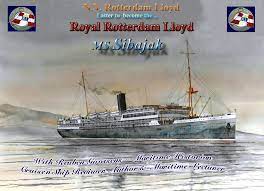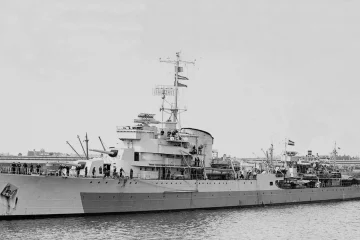
The MS Sibajak was a passenger ship named after Mount Sibayak, a volcano located in Sumatra, Indonesia. It was built at the Koninklijke Maatschappij “De Schelde” shipyard in Vlissingen, Netherlands. The ship was initially constructed for the N.V. Koninklijke Paketvaart-Maatschappij (KPM), a Dutch shipping company that operated in the Dutch East Indies (now Indonesia).
However, before the completion of the ship, it was decided that the vessel would be transferred to the Rotterdamsche Lloyd, another Dutch shipping company, in 1928. The Rotterdamsche Lloyd primarily operated passenger and cargo services between Europe and the Dutch East Indies.
The MS Sibajak was launched on October 20, 1927, and was completed in 1928. It had a gross tonnage of approximately 12,580 tons and measured about 165 meters in length. The ship had a distinctive appearance with two tall funnels and a single mast.
As a passenger ship, the MS Sibajak had accommodation facilities for both first-class and tourist-class passengers. It offered comfortable cabins, dining rooms, lounges, and other amenities to ensure a pleasant voyage. The ship played a significant role in facilitating travel and trade between Europe and the Dutch East Indies during the early 20th century.
During World War II, the MS Sibajak was requisitioned by the British Admiralty and converted into a troopship. It served in this capacity, transporting troops and supplies, until 1946. After the war, the ship was returned to the Rotterdamsche Lloyd and underwent renovations and reconversion to resume passenger service.
In the following years, the MS Sibajak continued its voyages between Europe and the Dutch East Indies, carrying passengers and cargo. However, with the changing landscape of travel and the declining demand for passenger ships, the vessel was eventually sold to Taiwanese shipbreakers in 1963. It was subsequently scrapped, marking the end of its service.
Brief historic overview
- 1927 Named: SIBAJAK for Rotterdamsche Lloyd Flag: Netherlands -Call sign: PHMD.
- 08.02.1928 Maiden voyage from Rotterdam to Batavia.
- 1935 Modernised and rebuilt to 12.226 brt at Rotterdamsche Droogdok Mij Rotterdam.
- 1940 Re-registered in Willemstad, Curacao and converted to a troop ship under the management of P&O Lines Flag: Netherlands Antilles.
- 10.1941 Chartered by British Ministry of War as troopship.
- 14.04.1941 Rebuilt as troopship for 2300 man in Singapore.
- 05.03.1946 Arrived in Amsterdam and in service for the owners again.
- 1946-1951 Chartered by Dutch government as troopship, shipping troops to the Netherlands Indies.
- 1951 Rebuilt to emigrant ship for 950 passengers at Rotterdamsche Droogdok Mij Rotterdam.
- 1953 Rebuilt to 12.342 grt.
- 1959 Sold for scrap.
- 25.08.1959 Arriving in Hongkong to be scrapped.
Recollections from emigrants
Janneke Hall
Our family of 5 arrived in Sydney in December 1950 on the Sibayak. We came from a little village in North Holland Brabant called Werkendam. I was 5 years old. We went to Bathurst migrant camp but we’re only there for a few weeks. Orbost then Oakleigh VIC were our next short stays. Then Ferny Creek after which we ended up in Belgrave in the Dandenongs where mum stayed until her death in 2004. Sadly my father Otto Ippel, died after only 3 years in Australia.
Ingrid Galea
I have been determined to ensure the following generations will be aware of their Dutch roots. I am also want them to be aware of the family’s migration experience. I have written several small books based on what I remember and what I have been told by my family. It is always sad to realise too late that my mother could have added so much more to the story if only I’d asked her more questions.
What I’m wondering is if anyone else is attempting to create written legacies for their family, recording their own immigration story? I’ve plundered family photograph albums to use the images which tell stories in themselves. I’ve also used National Archives if Australia and the Immigration Museum in Melbourne and anything online I can find.
Tina Namow
I came out here in 1950 on the Sibayak. We left from Rotterdam. I wrote my memoirs and they were published in 2021. I have little memory of Holland as I was only 2 years old but I wrote about being a migrant in the 50’s in Australia and the hardship my family faced. It is called I Won’t Settle for Less by Tina Namow. I was born in Breda.
Judy King
I arrived in 1956 age 11 also on the Sibajak and disembarked in Perth. My parents bought a milk bar on the swan river and (possibly because of language issues) went broke. Dad boarded a train to get work in Sydney as there was no work in Perth. Imagine coming from tiny little Nederland and seeing/experiencing our vast continent. I remember that it was all he could speak about for a while. They have since passed of course but I don’t think my mum was ever sorry she came here. My dad however got very homesick after a few years. I also need to ‘put pen to paper, and write some. Let’s to leave behind for my children and grandchildren so that they don’t forget their roots.
We came to Sydney on the same ship in October 1956. They were not the easiest of times especially hostel life and learning a new language. We also moved around the first 6 months. Never could understand why my parents left Holland and left everything I knew behind. The voyage was my highlight and perhaps instilled in me the love of travelling.
Ingrid Vos
My mother’s family came on the Sybayak too in 1952 from Rotterdam.. settled in Adelaide.
Margaret Barnes
We also arrived on the MS Sibayak in 1956 with three small children and another on the way. Mum was down with morning sickness for the entire seven week journey. Dad always said it was such a long journey. Both only has a few words of English. They did listen to tapes before the journey to pick up some common English words. Mum and dad left two big families behind in Haarlem to begin their adventure in this strange new land they knew very little about. I just couldn’t image what they went through, except that they always said it was their deep love and devotion for each other that kept them going. Your story does resonate with me as I am also wanting to put together my family’s story for our next generations never to forget their roots.
Rapport over een groep emigranten aan boord van de ‘Sibajak’,
K. Mulder & T.C. Kramer, Rapport over een groep emigranten aan boord van de ‘Sibajak’, Reis Rotterdam-Sydney, Februari-Maart 1951. Groningen: Sociologisch Instituut van de Rijksuniversiteit, 1951
Dit boek kun je niet aanvragen, maar wel inzien. Het ligt ter inzage op de volgende locatie:
See also: Dutch immigrant ships to Australia
Other stories and sources
Personal story of Family van der Net about their trip on the Sibajak


